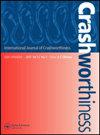Investigating road conditions of crash blackspots in Addis Ababa, Ethiopia: a random parameters negative binomial model
IF 2
4区 工程技术
Q3 ENGINEERING, MANUFACTURING
引用次数: 0
Abstract
AbstractCrash blackspots significantly impact and, to some extent, determines the entire road network’s safety level. Therefore, it is imperative to identify these blackspots and investigate the contributing factors. This becomes particularly crucial for low-income countries facing financial constraints in implementing road safety measures. Methodologically multiple studies utilised random parameter negative binomial models to predict vehicle crashes due to their ability to address unobserved heterogeneity in crash data, surpassing conventional models. However, the potential of this promising method in investigating factors influencing crash blackspots remains underutilised. This study aims to identify crash blackspots and investigates the roadway factors of such segments using the random parameters negative binomial modelling method. A three-year (2017–2019) crash data collected from the Ethiopian capital, Addis Ababa, with traffic volumes and various geometric characteristics were utilised. The model estimation results demonstrate the superiority of the random parameter negative binomial model over conventional models, showcasing its ability to reveal unobserved heterogeneity associated with road condition factors in crash blackspots. The study finds that horizontal curves and access density are significant road condition-related contributors to crash blackspots, characterised as random parameters. On the other hand, fixed-parameter influence factors include average annual daily traffic, vertical gradient, vertical curve, median width, and traffic control devices. The study highlights the need to further explore horizontal curvatures and access control as potential random parameters in crash blackspot locations. The findings may assist transportation planners/agencies in prioritising road maintenance, enhancing design standards, and implementing targeted safety interventions to improve road safety effectively.Keywords: Addis Ababacrash blackspotsnegative binomial modelroad conditionrandom parameters Disclosure statementNo potential conflict of interest was reported by the author(s).Additional informationFundingThis study was jointly supported by the National Natural Science Foundation of China (Grant Nos. 72371082, 71871189) and the China Scholarship Council.调查埃塞俄比亚亚的斯亚贝巴事故黑点的道路状况:一个随机参数负二项模型
摘要碰撞黑点严重影响并在一定程度上决定着整个路网的安全水平。因此,必须识别这些黑点并调查其成因。这对于在实施道路安全措施方面面临财政限制的低收入国家尤为重要。在方法上,多项研究利用随机参数负二项模型来预测车辆碰撞,因为它们能够解决碰撞数据中未观察到的异质性,优于传统模型。然而,这种有前途的方法在调查影响坠机黑点的因素方面的潜力仍未得到充分利用。本研究采用随机参数负二项建模方法,识别碰撞黑点,并研究碰撞黑点路段的道路因素。研究人员使用了从埃塞俄比亚首都亚的斯亚贝巴收集的三年(2017-2019年)车祸数据,包括交通量和各种几何特征。模型估计结果表明,随机参数负二项模型优于传统模型,能够揭示碰撞黑点中与道路状况因素相关的未观察到的异质性。研究发现,水平曲线和通道密度是与道路状况相关的碰撞黑点的重要因素,其特征为随机参数。另一方面,固定参数影响因素包括年平均日交通量、垂直梯度、垂直曲线、中位数宽度和交通控制设备。该研究强调需要进一步探索水平曲率和访问控制作为坠机黑点位置的潜在随机参数。研究结果可以帮助交通规划者/机构确定道路维护的优先顺序,提高设计标准,并实施有针对性的安全干预措施,以有效改善道路安全。关键词:亚的斯亚贝巴拉什黑点负二项模型道路条件随机参数披露声明作者未报告潜在的利益冲突。本研究由国家自然科学基金(资助号:72371082,71871189)和中国国家留学基金委共同资助。
本文章由计算机程序翻译,如有差异,请以英文原文为准。
求助全文
约1分钟内获得全文
求助全文
来源期刊

International Journal of Crashworthiness
工程技术-工程:机械
CiteScore
3.70
自引率
10.50%
发文量
72
审稿时长
2.3 months
期刊介绍:
International Journal of Crashworthiness is the only journal covering all matters relating to the crashworthiness of road vehicles (including cars, trucks, buses and motorcycles), rail vehicles, air and spacecraft, ships and submarines, and on- and off-shore installations.
The Journal provides a unique forum for the publication of original research and applied studies relevant to an audience of academics, designers and practicing engineers. International Journal of Crashworthiness publishes both original research papers (full papers and short communications) and state-of-the-art reviews.
International Journal of Crashworthiness welcomes papers that address the quality of response of materials, body structures and energy-absorbing systems that are subjected to sudden dynamic loading, papers focused on new crashworthy structures, new concepts in restraint systems and realistic accident reconstruction.
 求助内容:
求助内容: 应助结果提醒方式:
应助结果提醒方式:


